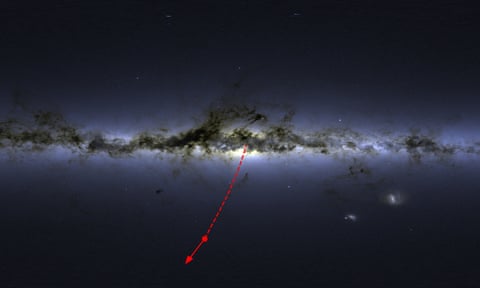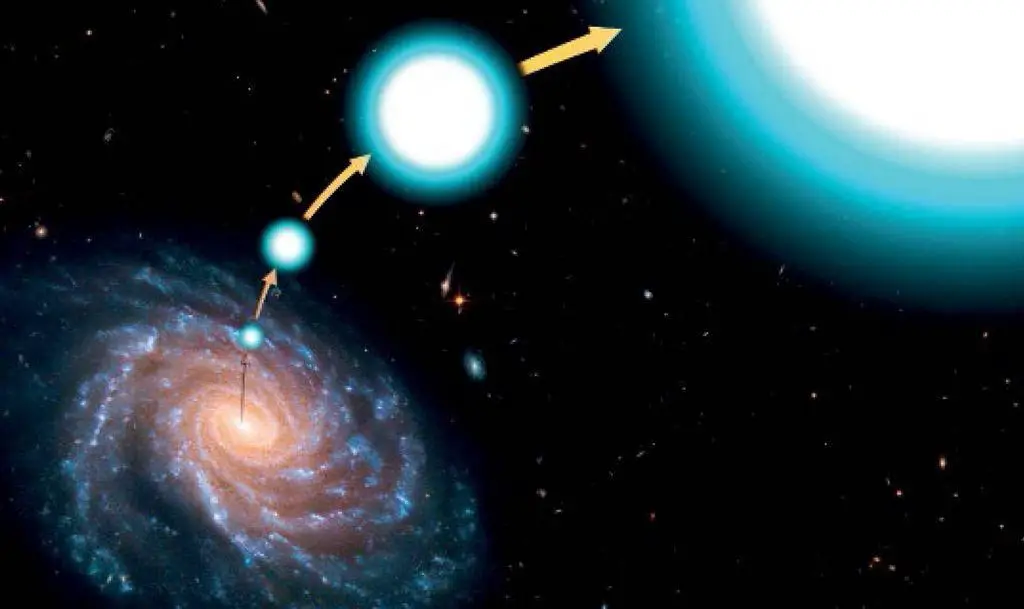Key Takeaways
- Astronomers discovered a star, S5-HVS1, speeding out of the Milky Way at 1,700 km/s.
- This event marks the first recorded instance of a star being ejected due to the galaxy’s supermassive black hole.
- The star was originally part of a binary system disrupted by the black hole at Sagittarius A*.
- The process behind this event, known as the Hills mechanism, was theorized over 30 years ago.
- S5-HVS1, the third-fastest star measured, will travel in intergalactic space indefinitely.
________
The star S5-HVS1 is set to drift alone through the universe at 1,700 km/s—10 times faster than most stars in our galaxy.

Astronomers recently documented an extraordinary discovery: a star, identified as S5-HVS1, being ejected from the Milky Way at a record-breaking speed of 1,700 km per second (over 6 million km/h). The star’s speed and trajectory are remarkable, making it one of the fastest-moving stars ever recorded. This cosmic event is believed to have been triggered by an encounter with Sagittarius A*, the supermassive black hole at the center of our galaxy. Predictions from over three decades ago suggested that black holes could fling stars at such immense speeds, but this is the first confirmed observation of the phenomenon. The star is moving so fast that in about 100m years it will exit the Milky Way and spend the rest of its life sailing alone through intergalactic space.
Gary Da Costa, an astronomer and professor emeritus at the Australian National University (ANU), led a team that traced S5-HVS1’s origins back to the heart of the Milky Way. The star’s expulsion occurred about 5 million years ago when it was part of a binary star system. As this system drifted close to Sagittarius A*, gravitational forces caused one star to become bound to the black hole while ejecting the other, S5-HVS1, into space. This process is called the Hills mechanism, named after Jack Hills, who proposed it in the late 20th century.
Dougal Mackey, a co-author and ANU College of Science member, emphasized that S5-HVS1 is significantly faster than most stars, including the Sun. Although other stars have reached high velocities through supernovae explosions, this is the fastest example driven solely by interaction with a black hole. The discovery was made using the 3.9-meter Anglo-Australian Telescope at ANU’s Siding Spring Observatory. The team’s primary project involved studying stellar streams in the galaxy’s halo, but they seized an opportunity to investigate other celestial bodies and stumbled upon this notable finding.
Once S5-HVS1 exits the Milky Way, it will traverse the vast emptiness of intergalactic space indefinitely. Da Costa explained that while it will eventually evolve into a white dwarf like the Sun, it will remain alone without neighboring stars for the remainder of its existence.
This discovery reinforces the longstanding hypothesis about black holes’ capacity to propel stars at extraordinary speeds and contributes to understanding gravitational interactions in our galaxy’s center.





Another reminder of exactly how big space is. Traveling at 6,000,000 km/h, it’s still going to take 100,000,000 years to leave this galaxy, and it won’t even hit another one before it dies.
I am trying to imagine a civilization that achieves astronomy under a lonely sun. Would their place in between the galaxies give them an advantage in understanding the universe, or would they have a hard time figuring things out, knowing about galaxies before they knew about stars?
Would the forces involved in ejecting it removed any planets that were in it’s orbit?
I often find myself panicking that there could be an asteroid, sun, black hole or some other object hurtling towards us at unimaginable speed. The whole Earth just gone in a second.
How crazy would it be if a billion years from now, intelligent life ended up evolving on a planet orbiting that star? A lone civilization on a solar system cruising through deep space between galaxies, with nothing else around for millions of light years.
Good thing it isn’t coming our way